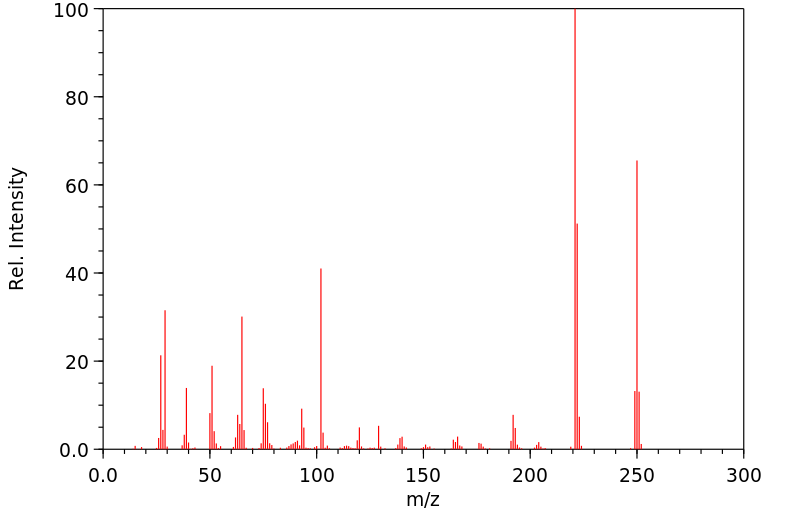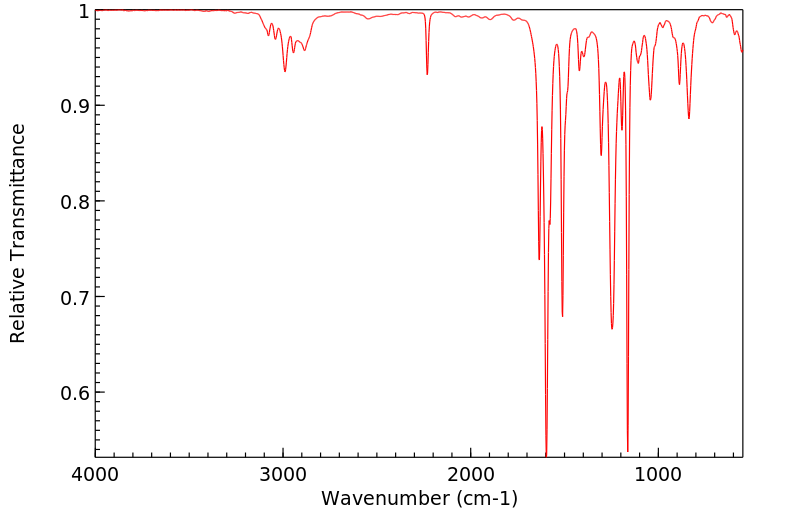N-(p-n-ethoxybenzylidene) p-n-cyanoaniline | 24742-30-1
中文名称
——
中文别名
——
英文名称
N-(p-n-ethoxybenzylidene) p-n-cyanoaniline
英文别名
(4'-ethoxybenzylidene) 4-aminobenzonitrile;4-ethoxybenzylidene-4'-aminobenzonitrile;N-(p-ethoxybenzylidene)-p'-cyanoaniline;p-(ethoxybenzylidene)-p-n-cyanoaniline;p-ethoxy benzylidene p'-cyano aniline;p-<(p-Aethoxy-benzyliden)-amino>-benzonitril;4-((4-Ethoxybenzylidene)amino)benzonitrile;4-[(4-ethoxyphenyl)methylideneamino]benzonitrile
CAS
24742-30-1
化学式
C16H14N2O
mdl
MFCD00043561
分子量
250.3
InChiKey
YFZISFITJTVAET-UHFFFAOYSA-N
BEILSTEIN
——
EINECS
——
-
物化性质
-
计算性质
-
ADMET
-
安全信息
-
SDS
-
制备方法与用途
-
上下游信息
-
文献信息
-
表征谱图
-
同类化合物
-
相关功能分类
-
相关结构分类
物化性质
-
沸点:429.9±30.0 °C(Predicted)
-
密度:1.04±0.1 g/cm3(Predicted)
计算性质
-
辛醇/水分配系数(LogP):3.3
-
重原子数:19
-
可旋转键数:4
-
环数:2.0
-
sp3杂化的碳原子比例:0.125
-
拓扑面积:45.4
-
氢给体数:0
-
氢受体数:3
安全信息
-
海关编码:2926909090
-
储存条件:室温
SDS
Section I.Chemical Product and Company Identification
Chemical Name 4'-Ethoxybenzylidene-4-cyanoaniline
Portland OR
Synonym Benzonitrile,4-[(E)-[(4-ethoxyphenyl)methylene]amino]-
(CA INDEX); 4-Ethoxybenzal-4'-cyanoaniline
Chemical Formula C16H14N2O
24742-30-1
CAS Number
Section II. Composition and Information on Ingredients
Chemical Name CAS Number Percent (%) TLV/PEL Toxicology Data
4'-Ethoxybenzylidene-4-cyanoaniline 24742-30-1 Min. 98.0 (T) Not available. Not available.
Section III. Hazards Identification
Harmful if ingested or inhaled. Minimize exposure to this material. Severe overexposure can result in injury or death. Follow
Acute Health Effects
safe industrial hygiene practices and always wear proper protective equipment when handling this compound.
CARCINOGENIC EFFECTS : Not available.
Chronic Health Effects
MUTAGENIC EFFECTS : Not available.
TERATOGENIC EFFECTS : Not available.
DEVELOPMENTAL TOXICITY: Not available.
Repeated or prolonged exposure to this compound is not known to aggravate existing medical conditions.
Section IV. First Aid Measures
Eye Contact Check for and remove any contact lenses. In case of contact, immediately flush eyes with plenty of water for at least 15
minutes. Get medical attention.
Skin Contact In case of contact, immediately flush skin with plenty of water. Remove contaminated clothing and shoes. Wash clothing
before reuse. Thoroughly clean shoes before reuse. Get medical attention.
Inhalation If the victim is not breathing, perform mouth-to-mouth resuscitation. Loosen tight clothing such as a collar, tie, belt or
waistband. If breathing is difficult, oxygen can be administered. Seek medical attention if respiration problems do not
improve.
Ingestion INDUCE VOMITING by sticking finger in throat. Lower the head so that the vomit will not reenter the mouth and throat.
Loosen tight clothing such as a collar, tie, belt or waistband. If the victim is not breathing, perform mouth-to-mouth
resuscitation. Examine the lips and mouth to ascertain whether the tissues are damaged, a possible indication that the toxic
material was ingested; the absence of such signs, however, is not conclusive.
Section V. Fire and Explosion Data
Not available.
Flammability May be combustible at high temperature. Auto-Ignition
Flammable Limits Not available.
Flash Points Not available.
Combustion Products These products are toxic carbon oxides (CO, CO2), nitrogen oxides (NO, NO2).
Fire Hazards
Not available.
Risks of explosion of the product in presence of mechanical impact: Not available.
Explosion Hazards
Risks of explosion of the product in presence of static discharge: Not available.
Fire Fighting Media
SMALL FIRE: Use DRY chemical powder.
LARGE FIRE: Use water spray, fog or foam. DO NOT use water jet.
and Instructions
Consult with local fire authorities before attempting large scale fire-fighting operations.
Continued on Next Page
4'-Ethoxybenzylidene-4-cyanoaniline
Section VI. Accidental Release Measures
Spill Cleanup Harmful material.
Use a shovel to put the material into a convenient waste disposal container. Finish cleaning the spill by rinsing any
Instructions
contaminated surfaces with copious amounts of water. Consult federal, state, and/or local authorities for assistance on
disposal.
Section VII. Handling and Storage
HARMFUL. Keep away from heat. Mechanical exhaust required. When not in use, tightly seal the container and store in a
Handling and Storage
dry, cool place. Avoid excessive heat and light. Do not breathe dust.
Information
Section VIII. Exposure Controls/Personal Protection
Use process enclosures, local exhaust ventilation, or other engineering controls to keep airborne levels below recommended
Engineering Controls
exposure limits. If user operations generate dust, fume or mist, use ventilation to keep exposure to airborne contaminants
below the exposure limit.
Personal Protection Splash goggles. Lab coat. Dust respirator. Gloves. Suggested protective clothing might not be sufficient; consult a specialist
BEFORE handling this product. Be sure to use a MSHA/NIOSH approved respirator or equivalent.
Exposure Limits Not available.
Section IX. Physical and Chemical Properties
Solid. (Light yellow crystalline powder) Solubility
Physical state @ 20°C Not available.
Not available.
Specific Gravity
Molecular Weight 250.3 Partition Coefficient Not available.
Boiling Point Not available. Vapor Pressure Not applicable.
Not available. Not available.
Melting Point Vapor Density
Not available. Volatility Not available.
Refractive Index
Not available.
Critical Temperature Not available. Odor
Viscosity Not available. Taste Not available.
Section X. Stability and Reactivity Data
Stability
This material is stable if stored under proper conditions. (See Section VII for instructions)
Conditions of Instability Avoid excessive heat and light.
Incompatibilities
Reactive with oxidizing agents.
Section XI. Toxicological Information
RTECS Number Not available.
Eye Contact. Ingestion. Inhalation.
Routes of Exposure
Toxicity Data Not available.
CARCINOGENIC EFFECTS : Not available.
Chronic Toxic Effects
MUTAGENIC EFFECTS : Not available.
TERATOGENIC EFFECTS : Not available.
DEVELOPMENTAL TOXICITY: Not available.
Repeated or prolonged exposure to this compound is not known to aggravate existing medical conditions.
Acute Toxic Effects Harmful if ingested or inhaled. Minimize exposure to this material. Severe overexposure can result in injury or death. Follow
safe industrial hygiene practices and always wear proper protective equipment when handling this compound.
Section XII. Ecological Information
Not available.
Ecotoxicity
Environmental Fate Not available.
Continued on Next Page
4'-Ethoxybenzylidene-4-cyanoaniline
Section XIII. Disposal Considerations
Waste Disposal Recycle to process, if possible. Consult your local regional authorities. You may be able to dissolve or mix material with a
combustible solvent and burn in a chemical incinerator equipped with an afterburner and scrubber system. Observe all
federal, state and local regulations when disposing of the substance.
Section XIV. Transport Information
Not a DOT controlled material (United States).
DOT Classification
PIN Number Not applicable.
Proper Shipping Name Not applicable.
Packing Group (PG) Not applicable.
DOT Pictograms
Section XV. Other Regulatory Information and Pictograms
TSCA Chemical Inventory This compound is ON the EPA Toxic Substances Control Act (TSCA) inventory list.
(EPA)
WHMIS Classification On NDSL.
(Canada)
EINECS Number (EEC) 246-445-6
EEC Risk Statements R20/21/22- Harmful by inhalation, in contact with skin and if swallowed.
SECTION 16 - ADDITIONAL INFORMATION
N/A
上下游信息
-
下游产品
中文名称 英文名称 CAS号 化学式 分子量 —— (4'-ethoxybenzylidene) 4-aminobenzonitrile 120191-53-9 C16H14N2O 250.3
反应信息
-
作为反应物:描述:N-(p-n-ethoxybenzylidene) p-n-cyanoaniline 以 氘代氯仿 为溶剂, 反应 24.0h, 生成 (4'-ethoxybenzylidene) 4-aminobenzonitrile参考文献:名称:Azobenzene crystal polymorphism enables tunable photoinduced deformations, mechanical behaviors and photoluminescence properties摘要:在偶氮苯分子晶体中调控多态性,使其表现出在光机械变形、力学行为和发光性能方面的显著差异。DOI:10.1039/d1tc01143j
-
作为产物:参考文献:名称:Ohgawara; Uchida; Wada, Molecular Crystals and Liquid Crystals (1969-1991), 1980, vol. 74, # 1-4, p. 227 - 242摘要:DOI:
文献信息
-
Choudary, L. V.; Rao, J. V.; Kishore, P. R., Zeitschrift fur Physikalische Chemie (Leipzig), 1988, vol. 269, # 1, p. 173 - 177作者:Choudary, L. V.、Rao, J. V.、Kishore, P. R.、Venkatacharyulu, P.DOI:——日期:——
表征谱图
-
氢谱1HNMR
-
质谱MS
-
碳谱13CNMR
-
红外IR
-
拉曼Raman
-
峰位数据
-
峰位匹配
-
表征信息
同类化合物
(R)-3-(叔丁基)-4-(2,6-二异丙氧基苯基)-2,3-二氢苯并[d][1,3]氧杂磷杂环戊烯
(2S,3R)-3-(叔丁基)-2-(二叔丁基膦基)-4-甲氧基-2,3-二氢苯并[d][1,3]氧杂磷杂戊环
(2S,2''S,3S,3''S)-3,3''-二叔丁基-4,4''-二甲氧基-2,2'',3,3''-四氢-2,2''-联苯并[d][1,3]氧杂磷杂戊环
(2R,2''R,3R,3''R)-3,3''-二叔丁基-4,4''-二甲氧基-2,2'',3,3''-四氢-2,2''-联苯并[d][1,3]氧杂磷杂戊环
(2-氟-3-异丙氧基苯基)三氟硼酸钾
(+)-6,6'-{[(1R,3R)-1,3-二甲基-1,3基]双(氧)}双[4,8-双(叔丁基)-2,10-二甲氧基-丙二醇
麦角甾烷-6-酮,2,3,22,23-四羟基-,(2a,3a,5a,22S,23S)-
鲁前列醇
顺式6-(对甲氧基苯基)-5-己烯酸
顺式-铂戊脒碘化物
顺式-四氢-2-苯氧基-N,N,N-三甲基-2H-吡喃-3-铵碘化物
顺式-4-甲氧基苯基1-丙烯基醚
顺式-2,4,5-三甲氧基-1-丙烯基苯
顺式-1,3-二甲基-4-苯基-2-氮杂环丁酮
非那西丁杂质7
非那西丁杂质3
非那西丁杂质22
非那西丁杂质18
非那卡因
非布司他杂质37
非布司他杂质30
非布丙醇
雷诺嗪
阿达洛尔
阿达洛尔
阿莫噁酮
阿莫兰特
阿维西利
阿索卡诺
阿米维林
阿立酮
阿曲汀中间体3
阿普洛尔
阿普斯特杂质67
阿普斯特中间体
阿普斯特中间体
阿托西汀EP杂质A
阿托莫西汀杂质24
阿托莫西汀杂质10
阿托莫西汀EP杂质C
阿尼扎芬
阿利克仑中间体3
间苯胺氢氟乙酰氯
间苯二酚二缩水甘油醚
间苯二酚二异丙醇醚
间苯二酚二(2-羟乙基)醚
间苄氧基苯乙醇
间甲苯氧基乙酸肼
间甲苯氧基乙腈
间甲苯异氰酸酯








